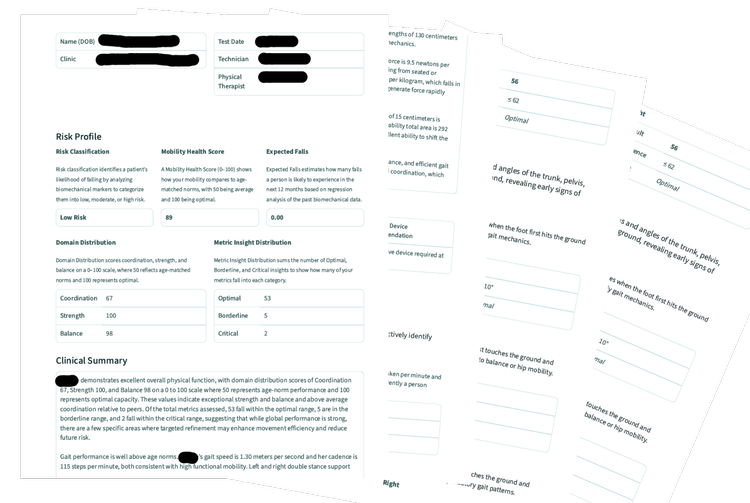Movement with clarity and rigor.
Moviq Health applies biomechanics science through structured, repeatable testing protocols to measure mobility with consistency. Our reports translate movement data into standardized baselines and longitudinal comparisons so clinics can document change and communicate mobility and function with clarity.

Understanding movement through biomechanics.
Two people may appear to walk the same, but their underlying mechanisms may be completely different. Understanding movement in details offers a detailed picture of how individuals navigate through daily life.
Moviq Health organizes biomechanical measurements into clear, high-resolution information that helps clinics observe movement with greater context, follow changes over time, and support meaningful discussions about functional health.
High-resolution data to enhance understanding
Describes timing, rhythm, and step characteristics that shape overall walking patterns.
Shows how different parts of the body move and coordinate during activity.
Summarizes how individuals generate and transfer force relative to their movement tasks.
Outlines patterns of balance control, sway, and the ability to maintain steady motion.
SCIENTIFIC FOUNDATION
From Research to Understanding
Research in biomechanics provides valuable insight into how people move and how movement patterns relate to strength, balance, and functional capacity.
Risk Assessment and Prevention of Falls in Older Community Dwelling Adults
Gait speed functions as a biomechanical vital sign, integrating coordination, force production, and balance. Slower speeds often reflect reduced push-off power and longer time spent in double support.
Read article
Functional Reach, Single-Leg Stance, and Tinetti Systematic Review
Many standard screens rely on subjective scoring. Objective biomechanical measurement better captures underlying mechanisms of balance, timing, and reactive control.
Read article
Lower Limb Strength and Prospective Falls
Weakness in the knee extensors and plantarflexors contributes to shorter steps, lower power output, and reduced walking rhythm—key predictors of fall risk.
Read article
CoP Displacement and Balance Control
Larger sway area and irregular pressure shifts reliably differentiate individuals with impaired stability and increased balance demands.
Read article
Gait Biomechanical Parameters Related to Falls
Reduced ankle push-off, diminished forward GRF progression, and variable step timing consistently correlate with increased fall risk.
Read article
Wearable Sensor Technology and Fall Risk
Wearable systems that capture step timing, turning mechanics, and trunk motion offer promising ways to evaluate gait and balance outside the clinic.
Read articleREPORT OVERVIEW
Inside a Moviq Health report
Each report organizes biomechanical metrics into a clear, easy-to-navigate format. The goal is to present information in a way that helps providers quickly understand patient's function.

-
1Mobility SummaryOffers a brief narrative description of observed movement characteristics, highlighting notable features across gait, balance, or force-related patterns.
-
2Metric DistributionDisplays how measurement values are distributed across reference values establised by the latest evidence.
-
3Biomechanics ResultsA clear display of results measured during the session, organized into domains.
IMPACT IN PRACTICE
What it means for your practice
Moviq Health organizes mobility-related information in a clear, accessible format so teams can review patterns efficiently within routine workflow.
See change sooner
Consistent check-ins make it easier to notice shifts in walking, balance, and strength over time.
Align the whole team
Share a common snapshot across providers so everyone references the same mobility picture at follow-ups.
Make follow-ups simpler
Standardized summaries help compare visits quickly and support practical next-step discussions with patients.
NEXT STEP
Bring high-fidelity mobility data into your practice.
If your clinic is exploring ways to make mobility a more visible part of care, we can walk you through the dashboard, the reports, and how Moviq Health supports your existing workflow.
REFERENCES
Key research behind Moviq Health.
- Montero-Odasso M, Kamkar N, Speechley M, et al. Risk assessment and prevention of falls in older community-dwelling adults: a review. JAMA. 2024;331(16):1397-1406. Source
- Omaña H, Bezaire K, Brady K, et al. Functional Reach Test, single-leg stance test, and Tinetti Performance-Oriented Mobility Assessment for the prediction of falls in older adults: a systematic review. Phys Ther. 2021;101(10):pzab173. Source
- Zhu RTL, Zuo JJ-J, Li K, et al. Association of lower-limb strength with different fall histories or prospective falls in community-dwelling older people: a systematic review and meta-analysis. BMC Geriatr. 2025;25:83. Source
- Quijoux F, Vienne-Jumeau A, Bertin-Hugault F, et al. Center of pressure displacement characteristics differentiate fall risk in older people: a systematic review with meta-analysis. Ageing Res Rev. 2020;62:101117. Source
- Silva J, Atalaia T, Abrantes J, Aleixo P. Gait biomechanical parameters related to falls in the elderly: a systematic review. Biomechanics. 2024;4(1):165-218. Source
- Subramaniam S, De Mello K, Martín-Rodríguez A, et al. Wearable sensor systems for fall risk assessment: a review. Sensors. 2022;22(3):984. Source
